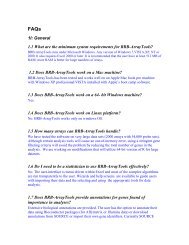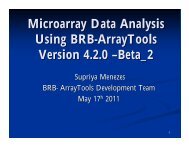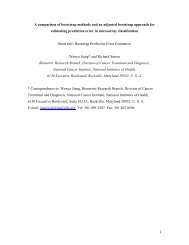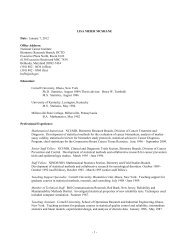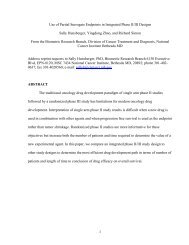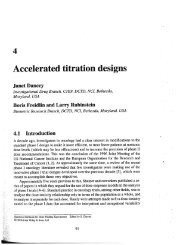Identification of Pharmacogenomic Biomarker Classifiers in Cancer ...
Identification of Pharmacogenomic Biomarker Classifiers in Cancer ...
Identification of Pharmacogenomic Biomarker Classifiers in Cancer ...
You also want an ePaper? Increase the reach of your titles
YUMPU automatically turns print PDFs into web optimized ePapers that Google loves.
tra<strong>in</strong><strong>in</strong>g set-test set partition, one can perform numerous unplanned analyses on the<br />
tra<strong>in</strong><strong>in</strong>g set to develop a classifier and then test that classifier on the test set. With<br />
multiple tra<strong>in</strong><strong>in</strong>g-test partitions however, that type <strong>of</strong> flexible approach to model<br />
development cannot be used. If one has an algorithm for classifier development, it is<br />
generally better to use one <strong>of</strong> the cross-validation or bootstrap resampl<strong>in</strong>g approaches to<br />
estimat<strong>in</strong>g error rate (see below) because the split sample approach does not provide as<br />
efficient a use <strong>of</strong> the available data {Mol<strong>in</strong>aro, 2005 #182}.<br />
Cross-validation is an alternative to the split sample method <strong>of</strong> estimat<strong>in</strong>g prediction<br />
accuracy{Radmacher, 2002 #15}. Mol<strong>in</strong>aro et al. describe and evaluate many variants <strong>of</strong><br />
cross-validation and bootstrap re-sampl<strong>in</strong>g for classification problems where the number<br />
<strong>of</strong> candidate predictors vastly exceeds the number <strong>of</strong> cases.{Mol<strong>in</strong>aro, 2005 #182} The<br />
cross-validated prediction error is an estimate <strong>of</strong> the prediction error associated with<br />
application <strong>of</strong> the algorithm for model build<strong>in</strong>g to the entire dataset.<br />
A commonly used <strong>in</strong>valid estimate is called the re-substitution estimate. You use all the<br />
samples to develop a model. Then you predict the class <strong>of</strong> each sample us<strong>in</strong>g that model.<br />
The predicted class labels are compared to the true class labels and the errors are totaled.<br />
It is well-known that the re-substitution estimate <strong>of</strong> error is highly biased for small data<br />
sets and the simulation <strong>of</strong> Simon et al.{Simon, 2003 #12} confirmed that, with a 98.2 %<br />
<strong>of</strong> the simulated data sets result<strong>in</strong>g <strong>in</strong> zero misclassifications even when no true<br />
underly<strong>in</strong>g difference existed between the two groups.<br />
14



